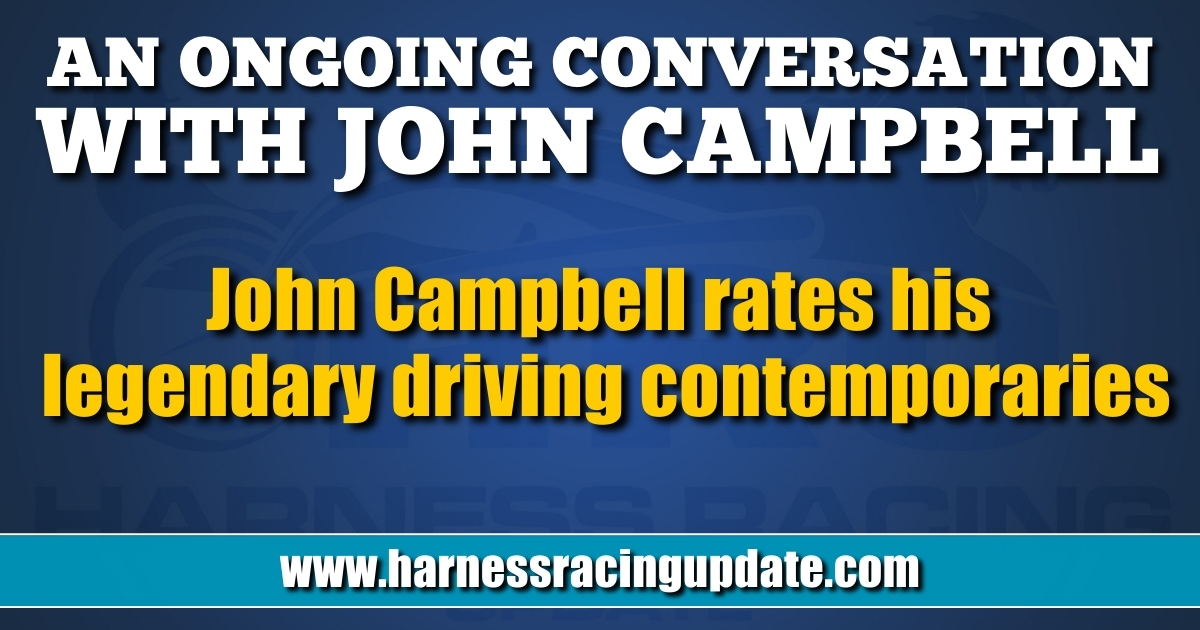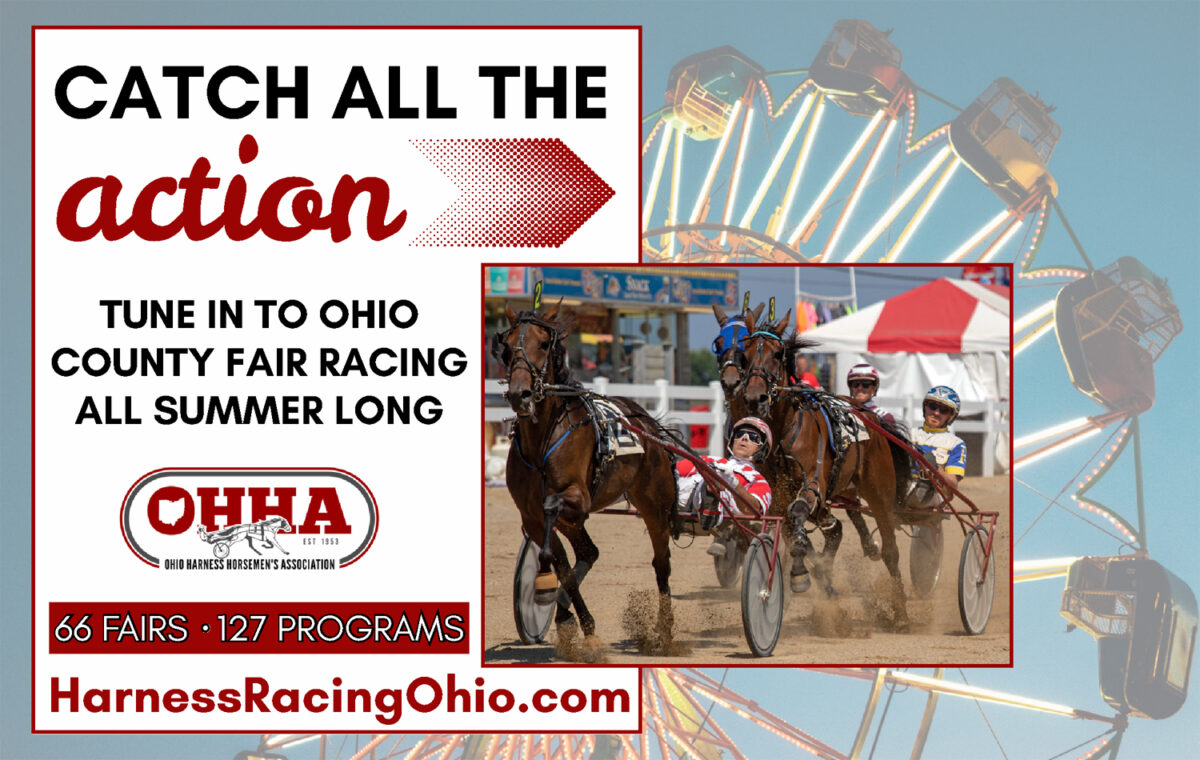John Campbell rates his legendary driving contemporaries
Though there was little separating the very best reinsmen in terms of talent, many names stand out for other reasons.
by Dave Briggs
Asking Hall of Fame driver and Hambletonian CEO John Campbell to assess his legendary driving contemporaries in multiple categories was, admittedly, a little challenging because of one over-riding reality:There truly was little separating the very top drivers from his era.
“So, saying, ‘who had the best hands?’ it is almost impossible to differentiate,” Campbell said. “Who had better hands than Billy O’Donnell? Or Mike Lachance? Or Buddy Gilmour or Herve [Filion]? Once you get to that level, that’s what made those guys so successful for so long and able to reach that height. It takes that package to be exceptional at it.”
But asked who among them was the best tactician on the track, Campbell did say Filion was, perhaps, at the top of the list.
“Again, once you get to that level, they all have to be great tacticians,” he said. “But, I will say, Herve was a master if he thought it was a two-horse race between your horse and his… He was a master of at least trying to get you in a disadvantaged situation… He put a lot of thought into that and did everything he could to get you into a spot where you didn’t want to be.”
Though, there is a qualifier.
“It was a little different back then, because horses could come from farther back,” Campbell said. “But, if you used your horse too much on the front they wouldn’t finish. It was a chess match among all of us, trying to get your horse in a spot close enough so you could win without using her too hard and then trying to get the guy that had the horse you thought you had to beat in a bad spot.”
As for the single greatest move Campbell said he ever witnessed from another driver, it was George Sholty’s move with Sonsam in the 1979 Meadowlands Pace in a then-world record of 1:53.2 from post 10. As Bob Heyden recently recalled, “It was the biggest purse, $750,000, at that time. [Sonsam] was three-, four-, and five-wide from past the half. Maybe the greatest effort ever!”
Campbell agreed.
“I just remember when [Sholty] moved [Sonsam], I thought, ‘Holy s – – -, look at this,’” Campbell said. “Then, the acceleration he had on the turn was absolutely incredible. To make a move is one thing, but for the horse to deliver for him is another… but it’s certainly one of the boldest moves I’ve ever seen and he just had so much confidence in the horse that it worked.
“I wasn’t in the race. I was watching and just from an entertainment value, I went, ‘Holy crap, I’ve never seen that before.’”
As for all-world trash talkers, Campbell said he and his peers didn’t trash talk all that much. However, in terms of arguments after races, he said he, “likely had more with Cat Manzi than with anybody else.”
He said both of them were just as guilty for post-race arguments fueled by competition on the track.
“It wasn’t for a long, long time,” Campbell said. “It was for a very short period of time, like early-’80s, and Cat was doing very well and winning lots of races — both of us were — and we just seemed to be digging into each other and had some back and forth… Some guys don’t engage and some guys do. Well, Cat and I engaged.”
Yet, in terms of pure intensity, it was another driver that topped them both — Mike Lachance.
“I don’t know if intense is the right word, but he was certainly focused,” Campbell said. “He totally lost his whole sense of humor when he was in that moment. It didn’t matter, you could come up with something really funny and he’d just look at you.
“He was just totally focused and intense, especially with big races coming up or on that night. Not that everybody else wasn’t intense, it was just that he focused more ahead of time than some people.”
As for the driver most likely to pick up the tab, Campbell said that was, likely, Gilmour.
But, times were a little different among the driving colony then compared to today, Campbell said.
“Today, they travel together on planes to go to races,” Campbell said. “When we started out, we all trained so we were all in the same barn area and ate in the same track kitchen, so you had to get along.”
As for the notion that today’s drivers are more aggressive than those of his era, Campbell said there is truth to that, but only because, “the horses can stand it… but it doesn’t matter which era you’re in, drivers in any era only do what works. That’s what makes them great.
“The strategies and how I raced from the time I started at The Meadowlands until when I quit at The Meadowlands, that changed dramatically. It’s not the drivers that changed, it’s the horses that changed.
“When I led the post parade at the Jug last fall, I did think, ‘Boy, it would be nice to have the rail in the final of the Jug and just go into that first turn as hard as the horse could go.’ I was a little nostalgic for that, just scoring down there. The horses have changed a little since I quit [driving in 2017], but not that much. I really did get in on both eras.”
REMEMBERING STAN BERGSTEIN
Campbell said there is no wonder why the late-and-legendary Stan Bergstein is the only person enshrined in both the U.S. Harness Racing Hall of Fame (immortals) and the U.S. Communicators Hall of Fame.
“There’s really been nobody else in history that’s done, across the board, everything that Stan did, at the level that Stan did, and had the visibility that he did,” Campbell said.
“He was an owner and then he was an announcer, a publicist, he worked for [Harness Tracks of America]… Just the breadth of what he brought to the table across the board was tremendous and the respect he had, not only inside the industry, but outside the industry from the thoroughbred folks. I had so much respect for him and got along so well with him on a personal note.”
Bergstein died in 2011, but is fondly remembered by many, including Campbell.
“I remember a lot of interactions with him,” Campbell said. “ He just did so much and brought such a broad scope of knowledge to the whole industry because he worked in almost every area, other than training and driving.”
In 2012, Campbell was awarded the very first Proximity Award renamed in Bergstein’s honor as the Stan Bergstein Proximity Award.
Short of induction into the Hall of Fame, the Stan Bergstein Proximity Award is the highest annual honor the United States Harness Writers Association bestows on recipients.
Campbell said he was deeply honored to receive that award, especially with Bergstein’s name attached. He also fondly remembers receiving the Stanley F. Bergstein Messenger Award in 1999. Campbell said he vividly remembers how special it was to physically receive that award from the man himself.
Recently, Campbell even stumbled upon the speech he gave at that time.
“I talked about how we don’t pay our race secretaries and judges enough,” Campbell said of his speech. “We have to attract more and better people for those positions – and that was 1999 and certainly nothing has changed since then.
“I also said we had two different issues as far as harness racing. If someone went to the Breeders Crown or the Meadowlands Pace or North America Cup or Hambletonian they would say there’s nothing wrong – they would see people around there having fun, a big crowd, great racing and all that, but if they came back on a Tuesday night in January at The Meadowlands then it would be a totally different story. I think at the time I was promoting making sure our big events were as big as they could be at that time… So, I think reading that and knowing I said that in 1999 kind of makes me feel pretty good, to tell you the truth.”

















